A Spatial Risk Analysis of Springtime Daily Minimum Surface Air Temperature Values for Vineyard Site Selection: Applications to Pinot noir Grapevines throughout the Willamette Valley American Viticultural Area
Abstract
:1. Introduction
2. Materials and Methods
2.1. Study Area
2.2. Pinot noir Cold Hardiness Data
2.3. Time Series Data
PRISM Gridded Temperature Data
2.4. Methods
2.4.1. Budbreak Calculations
2.4.2. Block Minima Dataset Development
2.4.3. Extreme Value Theory for Block Minima
2.4.4. Return Level Estimation and Gridded Pointwise Return Level Maps
3. Results and Discussion
3.1. Computed Budbreak Estimates
3.2. April 2022 Frost Event
3.3. Return Level Estimates for a Single PRISM Grid Data Location
3.4. Reclassified Gridded Return Level Maps
3.5. Spatial Vineyard Site Selection Combining Ripening Potential and Springtime Frost Risk
4. Conclusions
Author Contributions
Funding
Data Availability Statement
Acknowledgments
Conflicts of Interest
References
- Evans, K.J.; Bricher, P.K.; Foster, S.D. Impact of frost injury incidence at nodes of Pinot Noir on fruitfulness and growth-stage lag. Aust. J. Grape Wine Res. 2019, 25, 201–211. [Google Scholar] [CrossRef]
- Molitor, D.; Caffarra, A.; Sinigoj, P.; Pertot, I.; Hoffmann, L.; Junk, J. Late frost damage risk. Aust. J. Grape Wine Res. 2014, 20, 160–168. [Google Scholar] [CrossRef]
- Schultze, S.R.; Sabbatini, P. Impact of Early Season Temperatures in a Climate-Changed Atmosphere for Michigan: A Cool-Climate Viticultural Region. Atmosphere 2022, 13, 251. [Google Scholar] [CrossRef]
- Meier, M.; Fuhrer, J.; Holzkämper, A. Changing risk of spring frost damage in grapevines due to climate change? A case study in the Swiss Rhone Valley. Int. J. Biometeorol. 2018, 62, 991–1002. [Google Scholar] [CrossRef] [PubMed]
- Madelin, M.; Beltrando, G. Spatial interpolation-based mapping of the spring frost hazard in the Champagne vineyards. Meteorol. Appl. 2005, 12, 51–56. [Google Scholar] [CrossRef]
- Sugar, D.; Gold, R.; Lombard, P.; Gardea, A. Strategies for Frost Protection. In Oregon Viticulture; Hellman, E.W., Ed.; Oregon State University Press: Corvallis, OR, USA, 2002; pp. 213–217. [Google Scholar]
- Poling, E.B. Spring Cold Injury to Winegrapes and Protection Strategies and Methods. HortScience 2008, 43, 1652–1662. [Google Scholar] [CrossRef]
- Jones, G.V.; Hellman, E.W. Site Assessment. In Oregon Viticulture; Hellman, E.W., Ed.; Oregon State University Press: Corvallis, OR, USA, 2002; pp. 44–50. [Google Scholar]
- Yau, I.; Davenport, J.R.; Moyer, M.M. Developing a Wine Grape Site Evaluation Decision Support System for the Inland Pacific Northwestern United States. HortTechnology 2014, 24, 88–98. [Google Scholar] [CrossRef]
- Kurtural, S.K.; Dami, I.E.; Taylor, B.H. Utilizing GIS Technologies in Selection of Suitable Vineyard Sites. Int. J. Fruit Sci. 2007, 6, 87–107. [Google Scholar] [CrossRef]
- Tesic, D. Vineyard Location Analysis for Site Selection and Evaluation. Acta Hortic. 2004, 640, 27–35. [Google Scholar] [CrossRef]
- Nowlin, J.; Bunch, R.; Jones, G. Viticultural Site Selection: Testing the Effectiveness of North Carolina’s Commercial Vineyards. Appl. Geogr. 2019, 106, 22–39. [Google Scholar] [CrossRef]
- Kurtural, S.K.; Wilson, P.E. Vineyard Site Selection in Kentucky Based on Climate and Soil Properties; University of Kentucky College of Agriculture Cooperative Extension Service: Lexington, KY, USA, 1987; pp. 1–4. Available online: https://www2.ca.uky.edu/agcomm/pubs/ho/ho87/ho87.pdf (accessed on 28 February 2024).
- Chien, M.L. A Practical Guide to Developing a Commercial Wine Vineyard. Available online: https://www.vineyardteam.org/files/resources/Draft%20Copy%20of%20A%20Practical%20Guide%20to%20Developing%20a%20Commercial%20Wine%20Vineyard.pdf (accessed on 28 February 2024).
- Skinkis, P.A. Establishing a Vineyard in Oregon: A Quick-Start Resource Guide; Oregon State University Extension Service: Corvallis, OR, USA, 2022; pp. 1–9. Available online: https://extension.oregonstate.edu/pub/em-8973 (accessed on 28 February 2024).
- Winkler, J.; Cook, J.; Kliewer, W.M.; Lider, L.A. General Viticulture, 4th ed.; University of California: Berkeley, CA, USA, 1974. [Google Scholar]
- Jones, G.V.; Duff, A.; Hall, A.; Myers, J. Spatial Analysis of Climate in Winegrape Growing Regions in the Western United States. Am. J. Enol. Viticulture. 2010, 61, 313–326. Available online: https://www.ajevonline.org/content/61/3/313 (accessed on 5 January 2020). [CrossRef]
- Badr, G.; Hoogenboom, G.; Abouali, M.; Moyer, M.; Keller, M. Analysis of several bioclimatic indices for viticultural zoning in the Pacific Northwest. Clim. Res. 2018, 76, 203–223. [Google Scholar] [CrossRef]
- Jones, G.V. Climate and terroir: Impacts of climate variability and change on wine. In Fine Wine and Terroir: The Geoscience Perspective; Macqueen, R.W., Meinert, L.D., Eds.; Geoscience Canada Reprint Series; Geo-logical Association of Canada: St. John’s, NL, Canada, 2006; p. 203. [Google Scholar]
- Huglin, M. Nouveau Mode d’Évaluation des Possibilités Héliothermiques d’un Milieu Viticole. C. R. Acad. Agric. Fr. 1978, 64, 1117–1126. [Google Scholar]
- Parker, A.K.; García de Cortázar-Atauri, I.; Gény, L.; Spring, J.-L.; Destrac, A.; Schultz, H.; Molitor, D.; Lacombe, T.; Graça, A.; Monamy, C.; et al. Temperature-based grapevine sugar ripeness modelling for a wide range of Vitis vinifera L. cultivars. Agric. For. Meteorol. 2020, 285–286, 107902. [Google Scholar] [CrossRef]
- Ferguson, J.C.; Moyer, M.M.; Mills, L.J.; Hoogenboom, G.; Keller, M. Modeling Dormant Bud Cold Hardiness and Budbreak in Twenty-Three Vitis Genotypes Reveals Variation by Region of Origin. Am. J. Enol. Vitic. 2014, 65, 59–71. [Google Scholar] [CrossRef]
- Ferguson, J.C.; Tarara, J.M.; Mills, L.J.; Grove, G.G.; Keller, M. Dynamic thermal time model of cold hardiness for dormant grapevine buds. Ann. Bot. 2011, 107, 389–396. [Google Scholar] [CrossRef]
- Saxena, A.; Pesantez-Cabrera, P.; Ballapragada, R.; Lam, K.-H.; Keller, M.; Fern, A. Grape Cold Hardiness Prediction via Multi-Task Learning. Proc. AAAI Conf. Artif. Intell. 2023, 37, 15717–15723. [Google Scholar] [CrossRef]
- Gardea, A.A. Freeze Damage of Pinot Noir (Vitis vinifera L.) as Affected by Bud Development, INA Bacteria, and Bacterial Inhibitor. Master’s Thesis, Oregon State University, Corvallis, OR, USA, 1987. Available online: https://ir.library.oregonstate.edu/concern/graduate_thesis_or_dissertations/gt54kq01r (accessed on 11 August 2023).
- Levin, A.; Copp, C.; Skinkis, P. Resources for Vineyard Frost Protection; Oregon State University, Oregon Wine Research Institute: Corvallis, OR, USA, 2022; pp. 1–6. Available online: https://files.constantcontact.com/27fc1a43201/d4d977ab-eec3-470c-8e92-07951569b00f.pdf (accessed on 15 August 2023).
- Poni, S.; Sabbatini, P.; Palliotti, A. Facing Spring Frost Damage in Grapevine: Recent Developments and the Role of Delayed Winter Pruning—A Review. Am. J. Enol. Vitic. 2022, 73, 211–226. [Google Scholar] [CrossRef]
- Coombe, B.G. Adoption of a system for identifying grapevine growth stages. Aust. J. Grape Wine Res. 1995, 1, 104–110. [Google Scholar] [CrossRef]
- Willamette Valley Grape Crop Is Dealt a Frosty Blow. Producers Are Anxiously Wondering How Much of Their Crop Has Been Lost to Mid-April Willamette Valley Frost Event. Available online: https://www.decanter.com/wine-news/willamette-valley-grape-crop-is-dealt-a-frosty-blow-479866/ (accessed on 2 March 2024).
- Oregon Winemakers Still Reeling from Freak April Frost. Available online: https://ribbonridgewinery.com/oregon-winemakers-still-reeling-from-freak-april-frost/ (accessed on 2 March 2024).
- Willamette Valley Vintage Reviews. Available online: https://www.willamettewines.com/trade-resources/vintage-reviews/ (accessed on 2 March 2024).
- Jones, G.V.; McLain, M.; Hendricks, S. Winegrowing Regions. In Oregon Viticulture; Hellman, E.W., Ed.; Oregon State University Press: Corvallis, OR, USA, 2002; pp. 51–69. [Google Scholar]
- 2023 Oregon Wine Symposium|Climatology Report. Available online: https://industry.oregonwine.org/resources/workshops/2023-oregon-wine-symposium-climatology-report/ (accessed on 29 February 2024).
- 2023 Oregon Wine Symposium|Viticulture Track|Impacts and Learning from the 2022 Frost Event. Available online: https://industry.oregonwine.org/resources/workshops/2023-oregon-wine-symposium-viticulture-track-frost/ (accessed on 29 February 2024).
- Viglione, A.; Merz, R.; Salinas, J.L.; Blöschl, G. Flood frequency hydrology: 3. A Bayesian analysis. Water Resour. Res. 2013, 49, 675–692. [Google Scholar] [CrossRef]
- Coles, S.; Pericchi, L. Anticipating catastrophes through extreme value modelling. Appl. Stat. 2003, 52 Pt 4, 405–416. [Google Scholar] [CrossRef]
- Koss, W.J.; Owenby, J.R.; Steurer, P.M.; Ezell, D.S. Freeze/Frost Data; Climatography of the U.S. No. 20, Supplement No. 1; U.S. Department of Commerce, National Oceanic and Atmospheric Administration, National Climatic Data Center: Asheville, NC, USA, 1988; pp. 1–191.
- Thom, H.C.S.; Shaw, R.H. Climatological Analysis of Freeze Data for Iowa. Mon. Wea. Rev. 1958, 86, 251–257. [Google Scholar] [CrossRef]
- Thom, H.C.S. The distributions of freeze-date and freeze-free period for climatological series with freezeless years. Mon. Wea. Rev. 1959, 87, 136–144. [Google Scholar] [CrossRef]
- Vestal, C.K. First and last occurrences of low temperatures during the cold season. Mon. Wea. Rev. 1971, 99, 650–652. [Google Scholar] [CrossRef]
- Interpreting Freeze/Frost Probabilities from the National Centers for Environmental Information. Available online: https://content.ces.ncsu.edu/interpreting-freezefrost-probabilities-from-the-national-centers-for-environmental-information (accessed on 5 March 2024).
- Interactive Map: Average Date of Last Spring Freeze across the United States. Available online: https://www.climate.gov/news-features/understanding-climate/interactive-map-average-date-last-spring-freeze-across-united (accessed on 5 March 2024).
- Sgubin, G.; Swingedouw, D.; Dayon, G.; García de Cortázar-Atauri, I.; Ollat, N.; Pagé, C.; van Leeuwen, C. The risk of tardive frost damage in French vineyards in a changing climate. Agric. For. Meteorol. 2018, 250–251, 226–242. [Google Scholar] [CrossRef]
- van Leeuwen, C.; Sgubin, G.; Bois, B.; Ollat, N.; Swingedouw, D.; Zito, S.; Gambetta, G.A. Climate change impacts and adaptations of wine production. Nat. Rev. Earth Environ. 2024, 5, 258–275. [Google Scholar] [CrossRef]
- Frechet, M. Sur la loi de Probabilité de l’écart Maximum. Ann. Soc. Math. Polon. 1927, 6, 93–116. [Google Scholar]
- Fisher, R.A.; Tippett, L.H.C. Limiting forms of the frequency distribution of the largest or smallest member of a sample. Proc. Cambridge Phil. Soc. 1928, 24, 180–190. [Google Scholar] [CrossRef]
- Coles, S. An Introduction to Statistical Modeling of Extreme Values; Springer: London, UK, 2001; pp. 1–209. [Google Scholar]
- Petitjean, T.; Bonnardot, V.; Tissot, C.; Chassaing, T.; Quénol, H. Spatial representations of the maturity potential of Chardonnay and Chenin grape varieties in the Brittany and Pays de la Loire regions (1976–2100). Climatology 2023, 21, 2. [Google Scholar] [CrossRef]
- Skahill, B.; Berenguer, B.; Stoll, M. Temperature-based Climate Projections of Pinot noir Suitability in the Willamette Valley American Viticultural Area. OENO One 2022, 56, 209–225. [Google Scholar] [CrossRef]
- Skahill, B.; Berenguer, B.; Stoll, M. Climate Projections for Pinot Noir Ripening Potential in the Fort Ross-Seaview, Los Carneros, Petaluma Gap, and Russian River Valley American Viticultural Areas. Agronomy 2023, 13, 696. [Google Scholar] [CrossRef]
- PRISM Climate Group, Oregon State University, Data Created 4 February 2014. Available online: https://prism.oregonstate.edu (accessed on 23 March 2024).
- Jones, G.V.; White, M.A.; Cooper, O.R.; Storchmann, K. Climate change and global wine quality. Clim. Change 2005, 73, 319–343. [Google Scholar] [CrossRef]
- Jones, G.V. Climate change and the global wine industry. In Proceedings of the Thirteenth Australian Wine Industry Technical Conference, Adelaide, Australia, 28 July–2 August 2007. [Google Scholar]
- Willamette Valley. Available online: https://trade.oregonwine.org/resources/willamette-valley/ (accessed on 6 March 2024).
- Department of the Treasury. Bureau of Alcohol, Tobacco and Firearms. Treasury Decision ATF-162, Establishment of the Willamette Valley Viticultural Area; 48 Fed. Reg. 54220 (3 January 1984) (27 CFR Part 9); Bureau of Alcohol, Tobacco and Firearms: Washington, DC, USA, 1984.
- Department of the Treasury. Alcohol and Tobacco Tax and Trade Bureau. Treasury Decision TTB-134, Expansion of the Willamette Valley Viticultural Area; 81 Fed. Reg. 11110 (4 April 2016) (27 CFR Part 9); Alcohol and Tobacco Tax and Trade Bureau: Washington, DC, USA, 2016.
- 2022 Oregon Vineyard and Winery Report. Available online: https://industry.oregonwine.org/resources/reports-studies/2022-oregon-vineyard-and-winery-report/ (accessed on 5 March 2024).
- Zapata, D.; Salazar-Gutierrez, M.; Chaves, B.; Keller, M.; Hoogenboom, G. Predicting Key Phenological Stages for 17 Grapevine Cultivars (Vitis vinifera L.). Am. J. Enol. Vitic. 2017, 68, 60–72. [Google Scholar] [CrossRef]
- R Core Team. R: A Language and Environment for Statistical Computing; R Foundation for Statistical Computing: Vienna, Austria, 2022; Available online: https://www.R-project.org/ (accessed on 1 January 2024).
- Stephenson, A.G. evd: Extreme Value Distributions. R. News 2002, 2, 31–32. Available online: https://CRAN.R-project.org/doc/Rnews/ (accessed on 1 January 2024).
- Boessenkool, B. extremeStat: Extreme Value Statistics and Quantile Estimation. R package, version 1.5.9; 2024. Available online: https://CRAN.R-project.org/package=extremeStat (accessed on 1 January 2024).
- Vintage and Other Miscellaneous Reports, Vintage 2022, North Willamette Valley, Gregory V. Jones, Ph.D., CEO, Abacela Vineyards and Winery. Available online: https://www.climateofwine.com/_files/ugd/07f66e_4ccab8ed9dd345939d488cd0a906ffa8.pdf?index=true (accessed on 7 May 2024).
- Abatzoglou, J.T. Development of gridded surface meteorological data for ecological applications and modelling. Int. J. Climatol. 2013, 33, 121–131. [Google Scholar] [CrossRef]
- Livneh, B.; Rosenberg, E.A.; Lin, C.; Nijissen, B.; Mishra, V.; Andreadis, K.M.; Maurer, E.P.; Lettenmaier, D.P. A long-term hydrologically based dataset of land surface fluxes and states for the conterminous United States: Updates and extensions. J. Clim. 2013, 26, 9384–9392. [Google Scholar] [CrossRef]
- Pierce, D.W.; Cayan, D.R.; Thrasher, B.L. Statistical Downscaling Using Localized Constructed Analogs (LOCA). J. Hydrometeorol. 2015, 15, 2558–2585. [Google Scholar] [CrossRef]
- Pierce, D.W.; Cayan, D.R.; Maurer, E.P.; Abatzoglou, J.T.; Hegewisch, K.C. Improved bias correction techniques for hydrological simulations of climate change. J. Hydrometeorol. 2015, 16, 2421–2442. [Google Scholar] [CrossRef]
- Love, C.A.; Skahill, B.E.; Russell, B.T.; Baggett, J.S.; AghaKouchak, A. An Effective Trend Surface Fitting Framework for Spatial Analysis of Extreme Events. Geophys. Res. Lett. 2022, 49, e2022GL098132. [Google Scholar] [CrossRef]

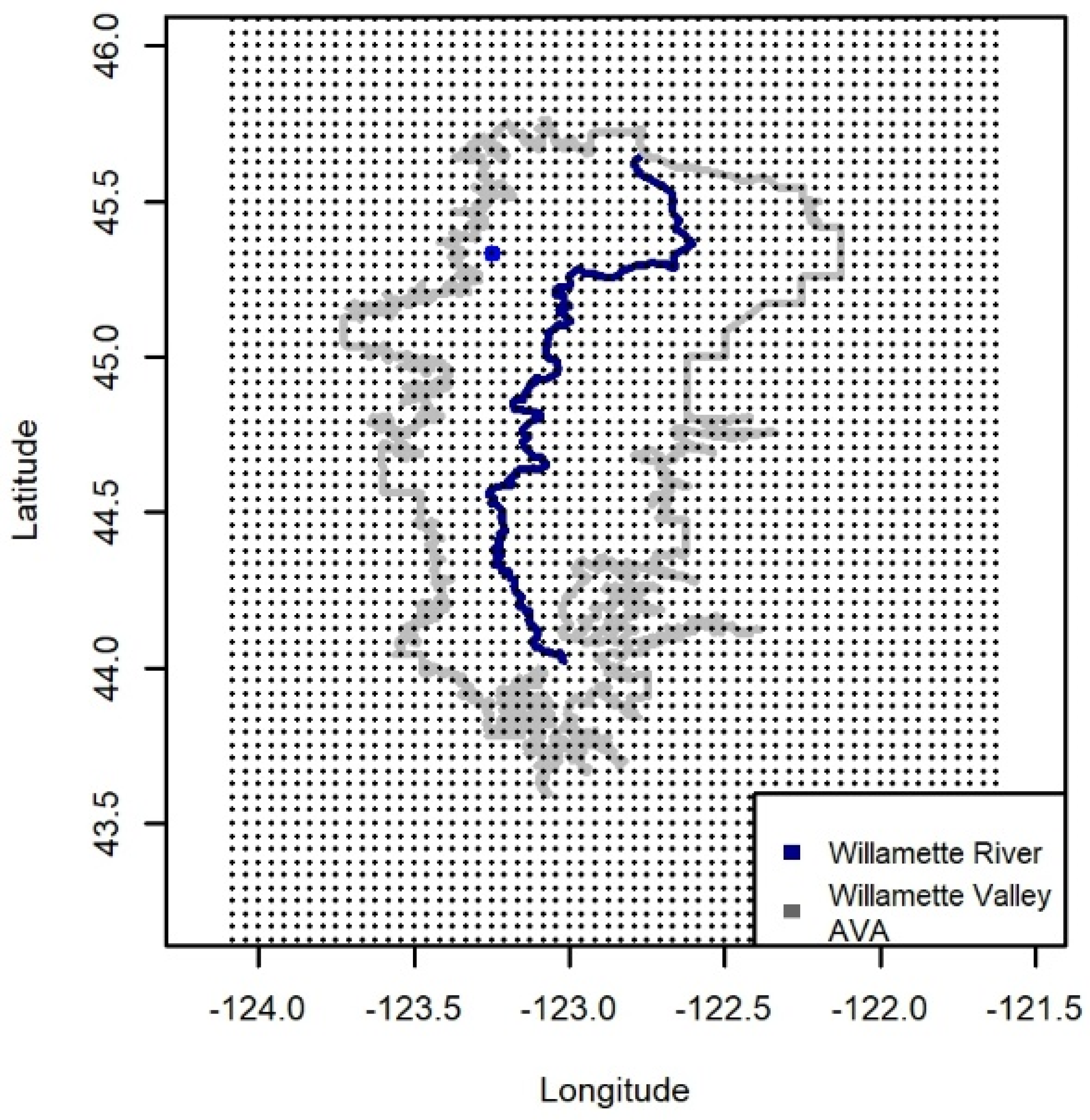

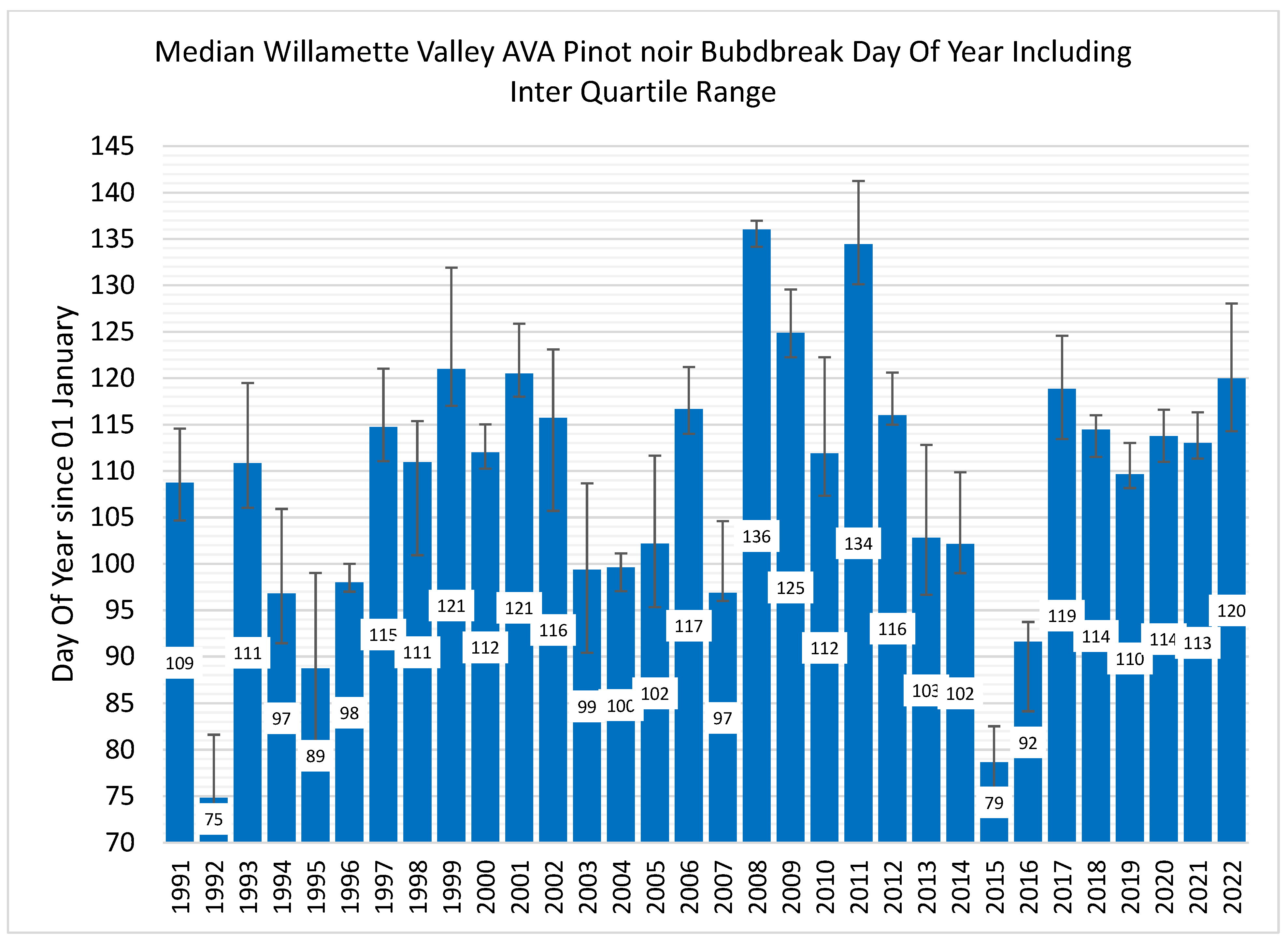

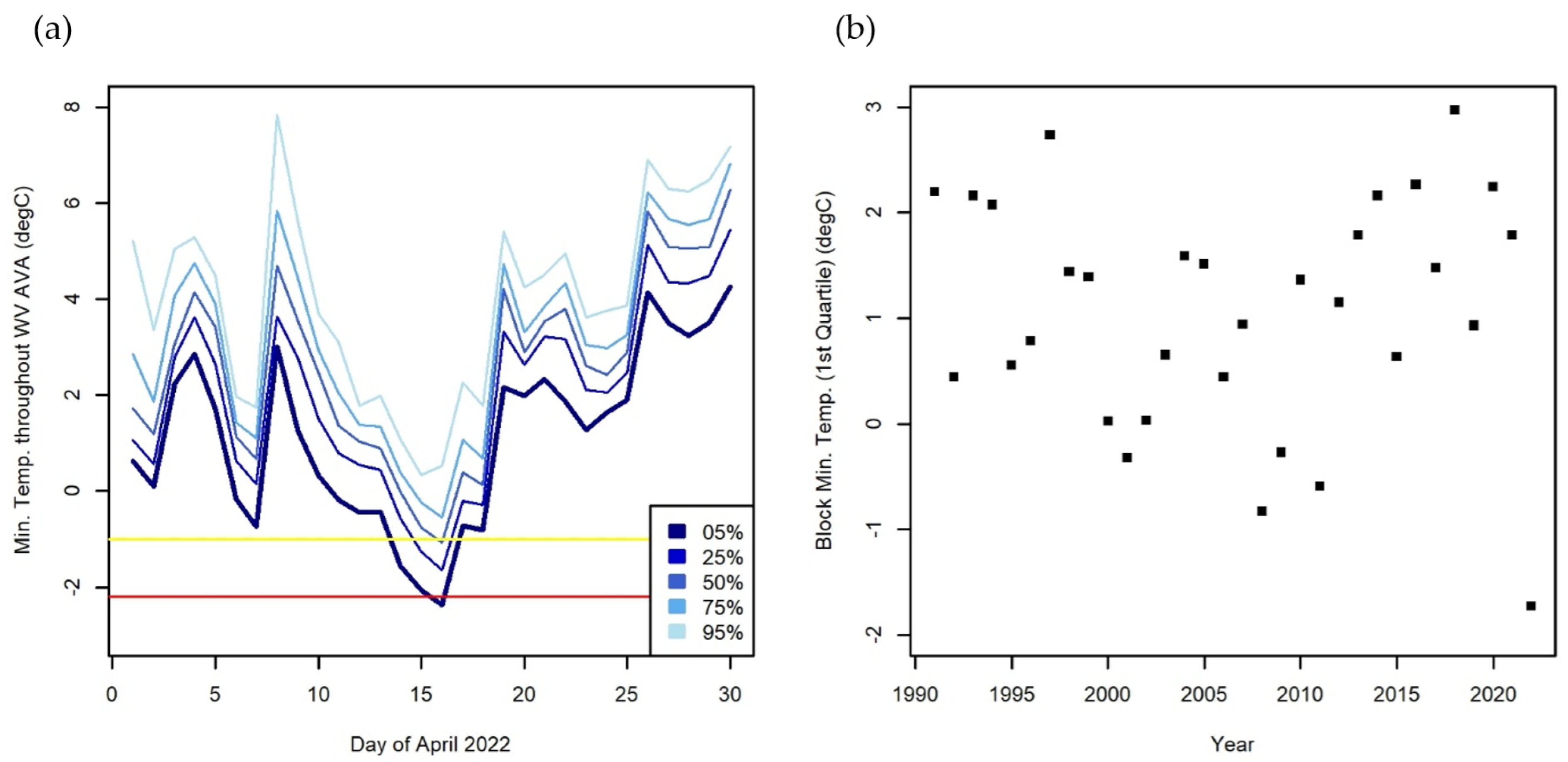
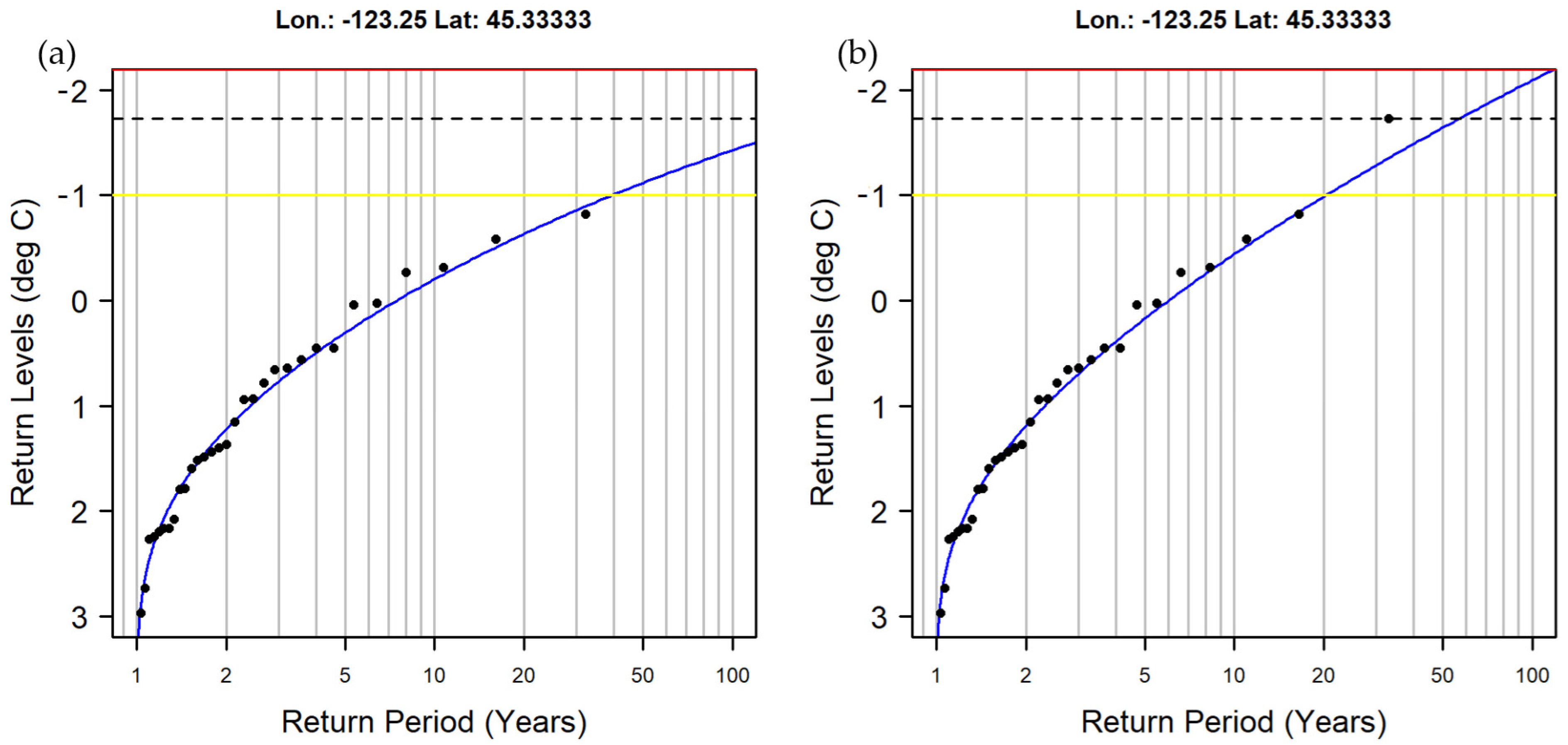
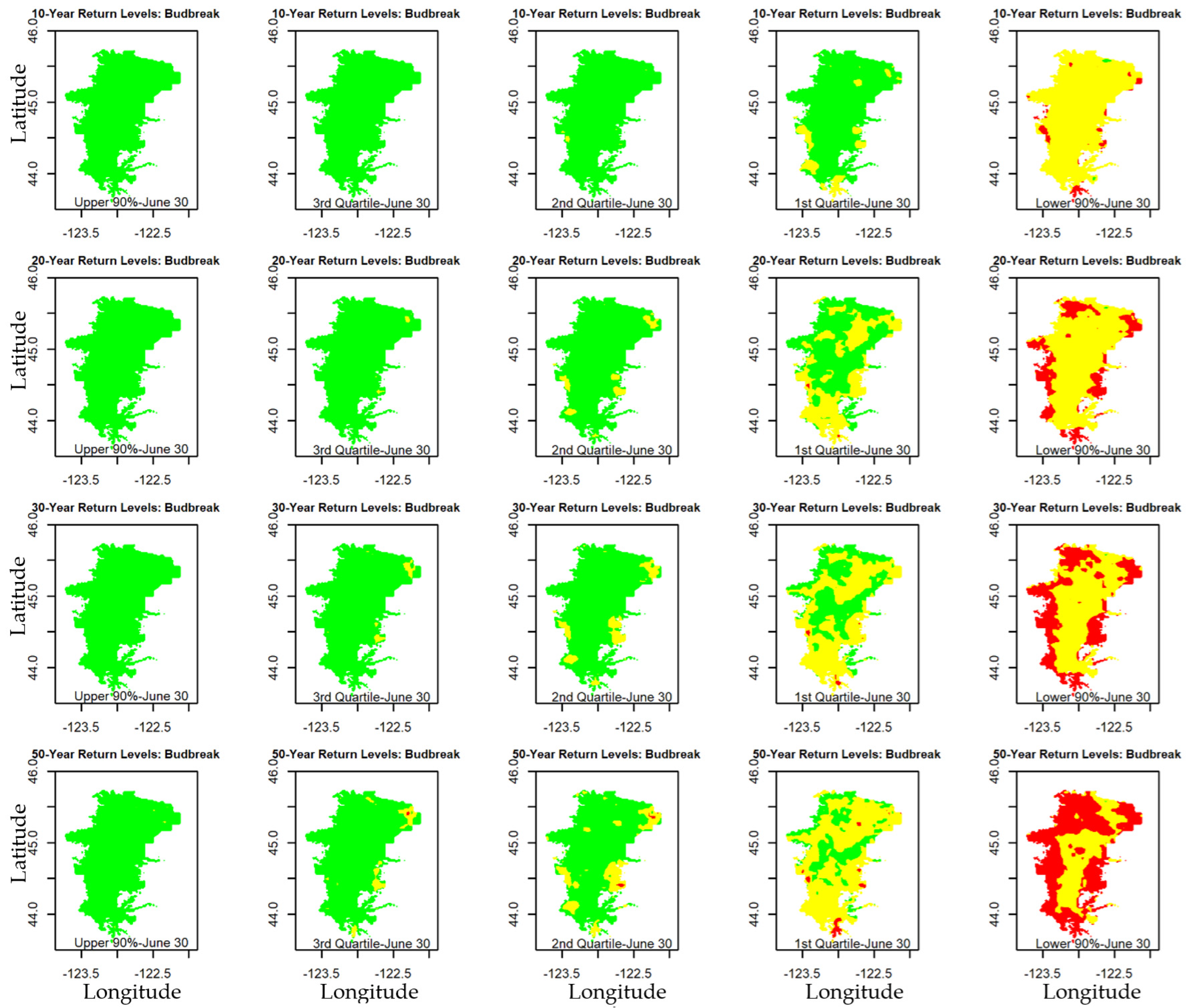


| Phenological Stage | E-L Stages [28] | No Injury (°C) | LT50 (°C) |
|---|---|---|---|
| Bud scales opening | 2 | NA | −14.0 |
| Woolly bud | 3 | NA | −3.4 |
| Budbreak | 4 | −1.0 | −2.2 |
| First leaf | 7 | −1.0 | −2.0 |
| Second leaf | 9 | −1.0 | −1.7 |
| Fourth leaf | 11 | −0.6 | −1.2 |
| % WV AVA | ||||||
|---|---|---|---|---|---|---|
| 20-Year (1991–2021) | 20-Year (1991–2022) | |||||
| No Injury | Injury but LT50 Not Exceeded | LT50 Exceeded | No Injury | Injury but LT50 Not Exceeded | LT50 Exceeded | |
| Upper 90% | 100 | 0 | 0 | 100 | 0 | 0 |
| 3rd Quartile | 99.48 | 0.52 | 0 | 99.56 | 0.44 | 0 |
| 2nd Quartile | 95.06 | 4.94 | 0 | 95.19 | 4.81 | 0 |
| 1st Quartile | 57.64 | 42.16 | 0.20 | 46.80 | 52.97 | 0.23 |
| Lower 90% | 0.07 | 75.33 | 24.60 | 0.08 | 73.78 | 26.14 |
| 30-year (1991–2021) | 30-year (1991–2022) | |||||
| Upper 90% | 100 | 0 | 0 | 100 | 0 | 0 |
| 3rd Quartile | 97.97 | 2.03 | 0 | 98.05 | 1.95 | 0 |
| 2nd Quartile | 90.96 | 9.04 | 0 | 90.67 | 9.33 | 0 |
| 1st Quartile | 41.53 | 57.93 | 0.54 | 29.51 | 69.96 | 0.54 |
| Lower 90% | 0.04 | 60.05 | 39.91 | 0.04 | 58.45 | 41.51 |
Disclaimer/Publisher’s Note: The statements, opinions and data contained in all publications are solely those of the individual author(s) and contributor(s) and not of MDPI and/or the editor(s). MDPI and/or the editor(s) disclaim responsibility for any injury to people or property resulting from any ideas, methods, instructions or products referred to in the content. |
© 2024 by the authors. Licensee MDPI, Basel, Switzerland. This article is an open access article distributed under the terms and conditions of the Creative Commons Attribution (CC BY) license (https://creativecommons.org/licenses/by/4.0/).
Share and Cite
Skahill, B.; Berenguer, B.; Stoll, M. A Spatial Risk Analysis of Springtime Daily Minimum Surface Air Temperature Values for Vineyard Site Selection: Applications to Pinot noir Grapevines throughout the Willamette Valley American Viticultural Area. Agronomy 2024, 14, 1566. https://doi.org/10.3390/agronomy14071566
Skahill B, Berenguer B, Stoll M. A Spatial Risk Analysis of Springtime Daily Minimum Surface Air Temperature Values for Vineyard Site Selection: Applications to Pinot noir Grapevines throughout the Willamette Valley American Viticultural Area. Agronomy. 2024; 14(7):1566. https://doi.org/10.3390/agronomy14071566
Chicago/Turabian StyleSkahill, Brian, Bryan Berenguer, and Manfred Stoll. 2024. "A Spatial Risk Analysis of Springtime Daily Minimum Surface Air Temperature Values for Vineyard Site Selection: Applications to Pinot noir Grapevines throughout the Willamette Valley American Viticultural Area" Agronomy 14, no. 7: 1566. https://doi.org/10.3390/agronomy14071566





